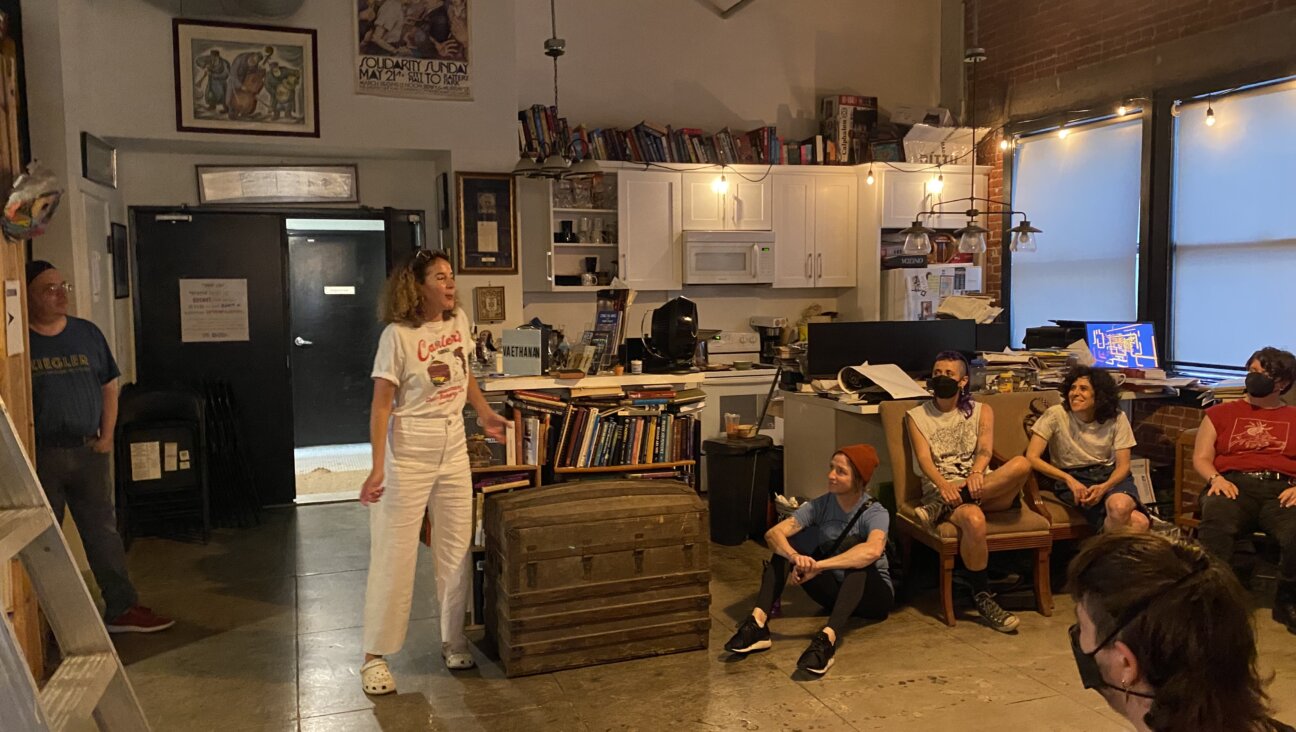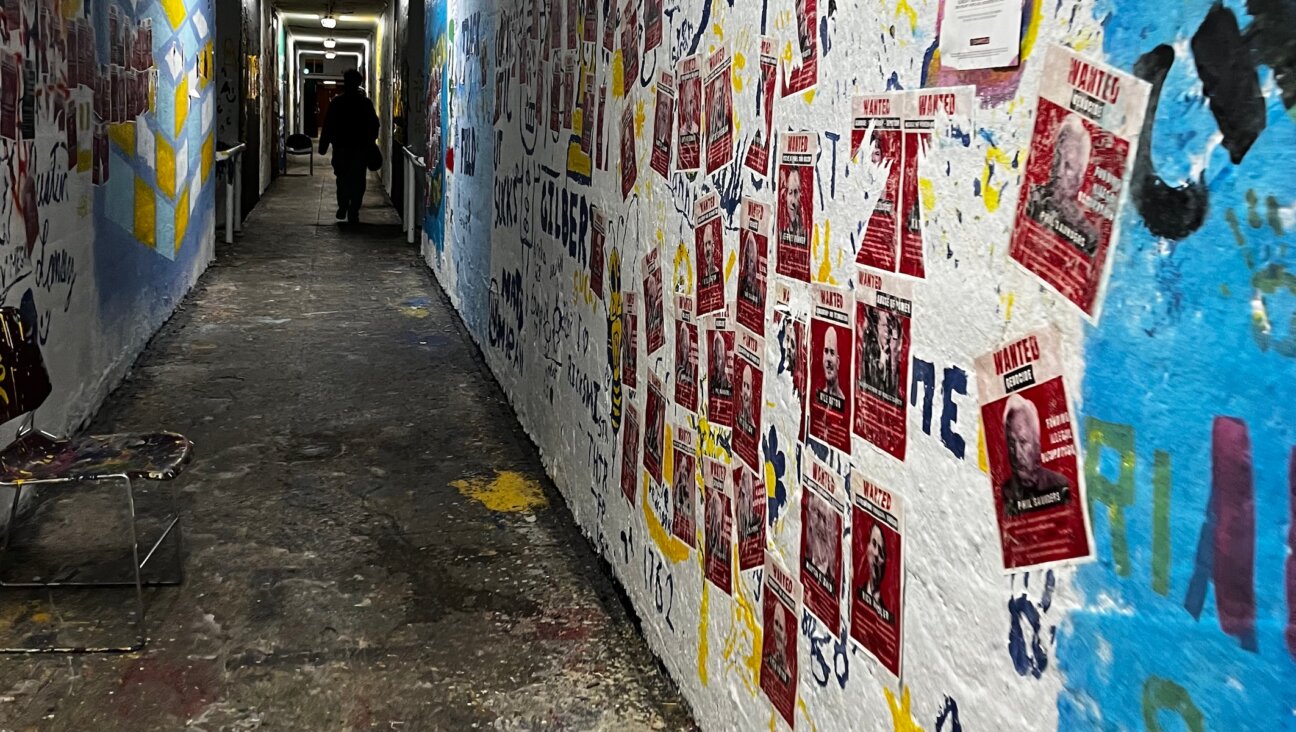At Israeli Outpost, Showdown Looms for Settlers, Government
AMONA — In the dark, the houses look like nine small, identical boxes — flat topped, faced in stone, windows shuttered — that have been dropped on the rocky, unpaved lots cut at the end of the ridge. Jerusalem, to the south, is a carpet of lights spread along the horizon. Behind the houses, the mobile homes of Amona are scattered along the shadowed, silent crest stretching northward.
The quiet is temporary. Amona, one of the oldest of the so-called outpost settlements established on West Bank hilltops over the past decade, is the latest flashpoint in the worsening relations between the settler movement and the Israeli government. Unless the Supreme Court extends a brief reprieve, the nine houses are to be demolished within the coming week. Army chief of staff Dan Halutz has reportedly assigned 1,300 troops to that task; they could face off with several thousand pro-settlement protesters. Government spokesmen are calling the looming showdown a major test of Israel’s commitment to “the values of the rule of law,” as Acting Prime Minister Ehud Olmert put it in his much-touted address this week to the annual Herzliya Conference.
The confrontation has mounted slowly. Israel’s civil administration in the West Bank issued demolition orders against Amona’s houses back in October 2004. According to attorney Talia Sasson’s government-commissioned report last spring on the “outpost” settlements, Amona stands on private Palestinian land and has none of the legally required planning permits. After the Peace Now movement went to court last summer to demand that the law be enforced, settlers who’d entered the houses moved out again. In November, Defense Minister Shaul Mofaz promised the court that he would carry out the demolition orders by the end of January.
At first glance, nothing was added by Olmert’s recent instructions to the military to go ahead with the demolition — or by his directive to evacuate two-dozen other outposts established since March 2001. The latter step only would fulfill Ariel Sharon’s promise under the American-sponsored road map to peace. But Sharon did nothing about the promise. Olmert, the accidental leader and surprise front-runner in the upcoming election, has publicly given himself a test to pass. He also has implied an assessment of the new Israeli politics: Confronting settlers, not supporting them, is now the way to win votes.
Pacing the tiny kitchen of his mobile home, Amona resident Eli Greenberg offers a larger context. “This struggle, now, is over defining what it means to be Jewish, defining what it means to be Israeli.” The comment could sound overblown. In fact, it represents the consensus of all sides in the fight over Amona and the outposts.
Eli Greenberg is thin, with a trim red beard, sidelocks and an oversized, crocheted skullcap. He and his wife grew up in Israeli towns near the coast. They spent years in the established West Bank community of Beit El before coming to Amona two years ago with their four children. Like other young, intensely ideological settlers, they saw Amona and other hilltop outposts like it — established since the government stopped approving new settlements in the mid-1990s — as “the real thing.”
In the Bible, Greenberg explains, Abraham began his spiritual journey by leaving Ur. He said that Ur means “city,” and that “being Jewish means leaving the city.” “We want to renew Jewish society according to biblical principles, following in the footsteps of Abraham, Isaac and Jacob.” God, he adds, “wants to see the fulfillment of all the prophecies… about the Land of Israel waiting with open arms to welcome her children back.”
It’s a terse statement of the settlement ethic, in the 2006 outpost edition: Along with the theological claim to land comes a rejection, nearly monastic, of urban life and Western culture. Words like “decadence” and “corruption” repeat when the couple speaks of secular Israel. Here, in the mountains, is where the patriarchs walked. “On the coastal plain, Jews barely lived,” Chana said. The coast, Eli added, was historically the territory “of non-Jews, of Philistines, Phoenicians, all sorts of Greeks….”
In the settler lexicon, “coastal plain” means the mostly secular cities of pre-’67 Israel; the mountains represent the religious settler movement. The geographic distinction stands for the deepening ideological struggle. Last summer’s evacuation of Gaza and the fight over the outposts represent a clash, Chana said, between “those who want a Jewish state” and those who would blur Israel’s Jewish identity.
The Arabs, Chana said, know that the country really belongs to the Jews. Nonetheless, Amona’s settlers say that they’ve bought the outpost’s real estate from Palestinian owners. The Israeli authorities, Eli said, have “tripped up” efforts to register the sale.
A different story was told by the state’s deposition to the Supreme Court in early January: It said that the settlers have made the same claim about legal purchase for a year-and-a-half, without showing any tangible evidence. What’s more, the state said, the construction is illegal anyway, since the land is zoned for farming.
There is, however, plenty of evidence that, in Chana Greenberg’s words, “the authorities encouraged building here,” acting “behind the scenes and by turning a blind eye.” According to the Sasson report, the Housing Ministry spent close to half-a-million dollars on infrastructure at Amona. The outpost is hooked to the national power grid, which requires Defense Ministry approval.
Which makes Amona unremarkable. Sasson’s tome documents a pattern of official support for more than 100 outposts. It errs only in describing such aid to unauthorized settlement as a recent problem. Ofra, Amona’s nearby “mother settlement” — an exurb of 2,500 people — was established in much the same way in 1975, with the help of then defense minister Shimon Peres. The practice of placing the cause above the law extends back to the earliest days of building settlements beyond the 1967 border. The outposts did, however, get a particular push from Sharon, longtime patron of the settler movement. While serving as foreign minister in 1998, Sharon declared on Israel Radio that settlers “should run, should grab more hills, expand the territory.… Everything we don’t grab will be in their hands.”
It is either unnerving or reassuring, therefore, to hear Ra’anan Gissin, Sharon’s longtime media adviser and now Olmert’s spokesman, explain by phone that there is “a matter of principle” of “the rule of law.” At high speed and high pitch, Gissin answers the policy question of the outposts with an impassioned riff on Locke, Hobbes, James Madison and the foundations of democracy in the social contract. The settlers “must decide, philosophically, what kind of state they want,” he said. Placing ideals over law risks a return to the state of nature, to anarchy. “They need to be read the liberal, democratic thinkers,” Gissin said, “and then they’ll understand.”
Gissin’s lecture is just one sign that the political current has shifted. Even hawkish Likud leader Benjamin Netanyahu expressed support this week, in a policy speech, for “dismantling outposts that lack legal approval,” promising that he would do so if elected prime minister.
It used to be that candidates on the left tried to position themselves to the right, said Hebrew University political scientist Yaron Ezrahi. “To succeed now,” he said, “rightists must move to the left.” The change, he says, goes beyond the outposts to the question of “What is the source of meaning in this enterprise?” meaning Jewish independence. The current choice, he asserted, is between democracy or “a fusion of nationalism and a redemptive religious vision.”
More than that, asserted Dror Etkes of Peace Now, it’s a question of “what sources Israel should draw on” — and of who has the right to interpret the Jewish sources. As head of Peace Now’s Settlement Watch, Etkes initiated the suit against Amona. “I want to join Judaism and universal values,” he said; the settlers want particularism. To show what drives him, he calls up two aerial photos on his laptop screen. One shows Amona today. The other shows the same hill in 1990, terraced and carpeted in the fields of local farmers.
The shift in political mood is not lost on the settler movement. The Council of Settlements in Judea, Samaria and Gaza was hoping to bring as many as 5,000 supporters to block the bulldozers at Amona. But spokeswoman Emily Amrusi said that this target was modest. The council had given up on bringing secular demonstrators, and much of the religious public had been “in despair” since the Gaza pullout.
“It will be mostly youth,” she said, and they would use “all means short of bodily harm” to stop the demolition. If that comes to pass, the identity of Israel will be debated on the Amona ridge in a most unphilosophical manner.
A message from our CEO & publisher Rachel Fishman Feddersen

I hope you appreciated this article. Before you go, I’d like to ask you to please support the Forward’s award-winning, nonprofit journalism during this critical time.
At a time when other newsrooms are closing or cutting back, the Forward has removed its paywall and invested additional resources to report on the ground from Israel and around the U.S. on the impact of the war, rising antisemitism and polarized discourse.
Readers like you make it all possible. Support our work by becoming a Forward Member and connect with our journalism and your community.
— Rachel Fishman Feddersen, Publisher and CEO






















